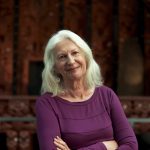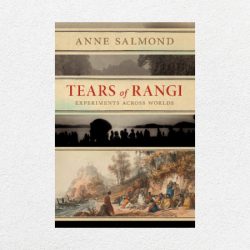Tears of Rangi
Experiments Across Worlds
Six centuries ago Polynesian explorers, who inhabited a cosmos in which islands sailed across the sea and stars across the sky, arrived in Aotearoa New Zealand where they rapidly adapted to new plants, animals, landscapes and climatic conditions. Four centuries later, European explorers arrived with maps and clocks, grids and fences, and they too adapted to a new island home. In this remote, beautiful archipelago, settlers from Polynesia and Europe (and elsewhere) have clashed and forged alliances, they have fiercely debated what is real and what is common sense, what is good and what is right. In this, her most ambitious book to date, Dame Anne Salmond looks at New Zealand as a site of cosmo-diversity, a place where multiple worlds engage and collide. Beginning with a fine-grained inquiry into the early period of encounters between Māori and Europeans in New Zealand (1769–1840), Salmond then investigates such clashes and exchanges in key areas of contemporary life – waterways, land, the sea and people. We live in a world of gridded maps, Outlook calendars and balance sheets – making it seem that this is the nature of reality itself. But in New Zealand, concepts of whakapapa and hau, complex networks and reciprocal exchange, may point to new ways of understanding interactions between peoples, and between people and the natural world. Like our ancestors, Anne Salmond suggests, we too may have a chance to experiment across worlds.

PREFACE
In the twenty-first century Pacific, the most iconic images of the Earth are those taken from outer space. A blue globe hangs in a pool of darkness, spinning in the sun. When the Pacific Ocean comes into sight, its scatter of islands is barely visible. Edged by the continents of Asia, Australia and the Americas, the scale of this great ocean is impressive. Marbled by drifts of cloud, the Pacific covers almost a third of the earth’s surface. In the far southern reaches, one can see the islands of New Zealand, the last significant land mass on Earth to be found and settled by people.
The ancestors of Māori invented blue-water sailing. As they sailed across the Pacific, stars, comets, clouds, the sun, the moon and birds appeared at different heights in the heavens. At night, successions of stars rose up in the sky, guiding them on their voyages. As winds blew and waves and swells slapped against the hulls of their canoes, it seemed that they stood still in the ocean while islands floated towards them.
The Brazilian anthropologist Viveiros de Castro has argued for the ‘ontological self-determination’ of the world’s peoples. Here, he is not talking about ‘world views’ (as though despite our different visions, there is just one world after all), or even ‘humanity’ or ‘the planet’, but suggesting that different peoples may explore different realities, and have the right to do so. For the Polynesian voyagers, a layered, curved universe in which islands sailed across the sea and stars across the sky was not a myth, but based on experience. Their explosive migrations east to Easter Island and the west coast of South America, north to Hawai‘i and south to New Zealand were made possible by a navigation system based on deep knowledge of the sea, winds and stars; fast, resilient canoes; a portable suite of plants and animals; and kin-based forms of order that allowed them to transplant themselves in new and unfamiliar lands.
When the first star navigators arrived in New Zealand in about the early fourteenth century, they had to rapidly adapt to plants and animals, landscapes and climatic conditions very different from those in their tropical homelands. By the time the first Europeans came ashore perhaps four hundred years later, Māori had developed many new technologies, along with new dialects, art forms and philosophical ideas. Far from a static ‘traditional’ society, early Māori life was dynamic and rapidly changing.
In order to reach these remote islands, the first Western explorers, Abel Tasman in 1642 and Captain James Cook in 1769–70, faced similar challenges. They had to master the art of sailing for long periods across great distances, along with technologies (including projectile weapons) that allowed them to survive the challenges from island warriors. At the time of the Endeavour’s arrival, life in Europe was also in a phase of explosive innovation. The settlers who arrived in the wake of the early European explorers brought with them new repertoires of plants and animals, habits of mind and ways of living, casting up realities that, like those of their Polynesian precursors, made it possible for them to inhabit places very different from their homelands.
Since the early nineteenth century in New Zealand, settlers from Polynesia and Europe (and elsewhere) have clashed and forged alliances with one another. In this remote, beautiful archipelago, debates over what is real, and good, and what matters in people’s lives have been fiercely contested. In these exchanges across the middle ground, ancestral Māori conceptions have been mobilised, usually but not always by Māori, and Western frameworks deployed, mostly but not invariably by Europeans. In the process, deep-seated assumptions and forms of order (so often invisible, or naturalised as ‘common sense’) have been brought to light, and challenged. At times – when the Treaty of Waitangi was signed between Māori and the British Crown; or New Zealand became the first country in the world to give the vote to women; or the Treaty settlement process was established; or the Whanganui River was recognised as a legal person – these exchanges have helped to provoke new ways of thinking.
Here, I want to explore the likelihood that like bio-diversity, cosmodiversity (in the sense of multiple ‘worlds’) may be a force for adaptation and survival. For the old Cartesian dualisms and their fragmented dreams are no longer working – in science, in material matters, or in human affairs. In order to find more adaptive ways of being, exchanges across different realities may be helpful, allowing new forms of order to emerge. In New Zealand, and elsewhere in the Pacific where ancestral insights remain vital, this can happen. The first part of this book examines such ‘experiments across worlds’ through a fine-grained inquiry into the early period of encounters between Māori and Europeans in New Zealand (1769–1840), when collisions and exchanges between people holding different assumptions about ‘how the world works’ were particularly stark and vivid. The second part of the book investigates such engagements in particular areas of life – waterways, land, the sea, and people; and asks whether these might help to open up new pathways to the future.
Whakapapa (genealogy), for instance, a way of being based on complex networks that encompass all forms of life, interlinked and co-emergent, might assist in exploring relational ways of understanding the interactions between people and the land, other life forms, waterways and the ocean. The idea of the hau, the wind of life that activates human and non-human networks alike, animated by reciprocal exchanges; or the spiral of space-time in Māori might help in devising non-linear, recursive ways of investigating the dynamic interactions among different life-forms (including people). This is fitting, because in Māori ways of thinking, knowledge itself is a taonga (ancestral treasure). As knowledge is given or received, hau passes back and forth across the pae – the horizon or threshold between sky and earth, light and dark, local people and visitors, life and death, past and present – reshaping realities and shifting the way that things happen. The pae is a volatile, emergent space, now and then flashing out insights that create new kinds of order.
As my mentor Eruera Stirling once said, ‘Knowledge is a blessing on your mind, it makes everything clear and guides you to do things in the right way . . .’ This book about experiments across worlds is written in that hope, and spirit.
Hope you enjoyed this preview. Borrow a copy from your nearest library, treat yourself and buy a copy from your local bookshop or gift it to somebody special.


